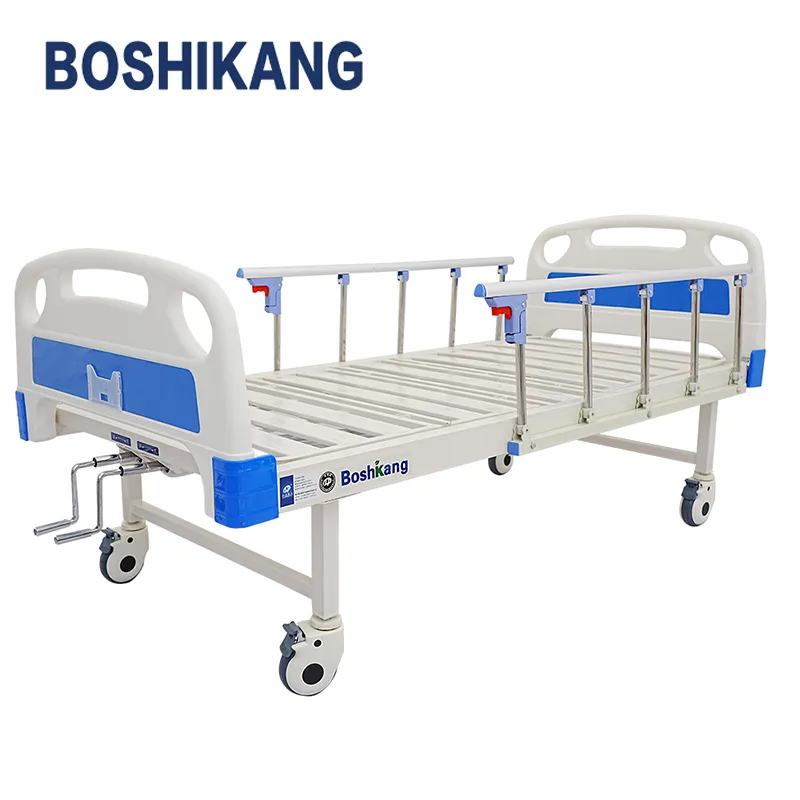Essential Adjustability Functions for ICU Beds
Position Control: Head, Foot, and Height Adjustments
ICU beds with position control features make a big difference in patient care because they let medical staff adjust how patients lie based on what their bodies need. Most modern ICU beds can be tweaked in several ways. Raising the head part helps people breathe better, while lifting the legs improves blood flow and takes pressure off feet and ankles. These changes matter a lot since different medical situations require different positions to keep patients comfortable and avoid problems down the road. Being able to change the bed height isn't just convenient either. When moving patients around, this feature makes transfers much safer for both the person being moved and the caregiver doing the work. Hospitals that invest in good position control systems generally see better recovery rates and fewer complications during treatment.
Specialized Positions: Trendelenburg and Cardiac Chair
Medical professionals often use the Trendelenburg position during surgeries and emergencies. Basically, this means raising a patient's legs so they're higher than their head. It helps get blood flowing better and keeps blood pressure stable when someone is in crisis. The reason it works comes down to gravity pulling blood toward the heart area, something that matters a lot when quick action is needed. For cardiac patients, there's another option called the cardiac chair position where patients can sit upright. This makes breathing easier as lungs expand naturally without resistance. Most modern ICU beds come equipped with both these positioning options. They make a real difference in patient recovery rates while also providing much needed comfort. When hospitals integrate these features into daily practice, they see fewer complications and generally better results across different types of critical care situations.
Critical Safety Mechanisms in ICU Bed Design
Fall Prevention Systems and Side Rails
In ICU settings, fall prevention systems for hospital beds are absolutely necessary to cut down on those dangerous patient falls that happen all too often. The adjustable side rails on these beds make a huge difference for safety reasons. They give patients something to hold onto when they need it most, stopping unexpected tumbles from happening while still letting them move around as needed. Most modern ICU beds come equipped with rails that医护人员 can tweak to different heights depending on what each individual patient needs. And once set at the right level, these rails lock into place pretty securely so there's no worry about them shifting during the night or when someone is trying to get up. This kind of customization really matters because every patient has different mobility challenges and comfort preferences.
Various side rail designs cater to different patient needs, such as half-length rails for easy access and full-length rails for maximum security. This customization ensures that patients receive individualized care tailored to their specific needs.
Emergency Braking and Locking Features
The emergency braking systems on ICU beds really matter because they stop the bed from moving unexpectedly while transporting patients or dealing with emergencies. Without them, accidental shifts could seriously injure someone who's already vulnerable. Most modern systems lock down fast enough so the bed stays put even during urgent situations where every second counts. Lock mechanisms themselves are pretty important too. They prevent those annoying little movements that happen when nurses need to roll the bed across the floor between rooms. For everyone involved, whether it's the person lying there recovering or the staff trying to do their job safely, having reliable brakes makes all the difference during transfers and other medical procedures throughout the hospital day.
Effective locking mechanisms foster a safe environment, reducing caregiver strain and enhancing patient safety during intricate procedures. Proper use of these mechanisms in ICU beds exemplifies their importance in maintaining operation stability and ensuring patient and caregiver safety.
Comfort and Clinical Support Features
Pressure-Relief Mattress Technology
Pressure-relief mattresses are essential in preventing pressure ulcers, a common complication for ICU patients. There are different mattress technologies available that cater to specific needs:
- Foam mattresses offer a consistent surface for distributing weight evenly, thus minimizing pressure points.
- Air mattresses can be adjusted for firmness and provide precise pressure relief through alternating air cells.
- Gel mattresses combine cushioning with cooling properties, enhancing patient comfort.
These innovative mattress systems not only promote patient comfort but are instrumental in supporting the recovery process, which hinges on minimal discomfort and effective sleep hygiene.
Infection Control Surfaces and Materials
Infection control is paramount in ICU settings, where the risk of cross-contamination is high. ICU bed surfaces play a crucial role in mitigating these risks. Manufacturers utilize antimicrobial fabrics and easy-to-clean surfaces to support stringent hygiene protocols.
- Antimicrobial upholstery is designed to inhibit bacterial growth.
- Easy-to-clean surfaces ensure quick sanitation between patient use.
Implementing effective infection control practices significantly reduces healthcare-associated infections (HAIs), which, in turn, decreases healthcare costs and improves patient outcomes. When choosing ICU beds, considering infection-resistant materials is a proactive step toward achieving a cleaner environment and enhancing overall care quality.
Transport and Mobility Capabilities
Caster Quality and Maneuverability
Good quality casters make all the difference when moving patients around intensive care units. They let medical staff roll beds through narrow hallways and past equipment without jostling fragile patients. Most modern hospital beds come with swivel casters that turn easily in tight spaces, something nurses appreciate during those late night transfers between rooms. Locking mechanisms on these wheels prevent accidental rolling when caregivers need to adjust IV lines or monitor vitals. Hospital administrators know that investing in durable, well-designed casters pays off long term since poor mobility solutions lead to worker injuries from pushing heavy loads and increased risk of patient falls during transport.
Battery Backup Systems for Critical Care
Battery backup systems are crucial for maintaining ICU bed functionality during power outages. These systems are designed to ensure uninterrupted care, especially for critically ill patients whose conditions could deteriorate without consistent support. Investing in robust battery backup solutions is integral to safeguarding patient care continuity in unpredictable situations.
Medical Equipment Integration
Accessory Mounting Systems
Mounting systems for accessories make a big difference in how well ICU beds function because they let hospitals attach important medical gear right onto the bed itself. The systems work with all sorts of equipment including IV poles, heart monitors, and other tracking devices so nurses don't have to hunt around for them during emergencies. When everything is mounted properly, it saves time and space in already crowded hospital rooms. Clinicians find this setup much better since critical tools stay put instead of getting lost among rolling carts or standing alone somewhere else in the room. For patients too, having necessary instruments close at hand means faster response times when something goes wrong.
Life-Support Device Compatibility
Getting life support devices to work together properly matters a lot when it comes to keeping patients safe and monitored effectively in intensive care units. Most ICU beds come with built-in connections for various essential machines like ventilators, heart rate monitors, and oxygen control systems that doctors rely on during critical treatment. The design of these hospital beds needs to make space for all this equipment while still maintaining safety standards and easy access points so medical staff can reach what they need quickly. Good bed design helps maintain consistent patient care even during those high pressure moments when every second counts in an emergency situation.

Durability and Compliance Standards
Weight Capacity and Structural Integrity
Knowing how much weight ICU beds can handle and whether they stay structurally sound matters a lot when it comes to keeping patients safe. Most ICU beds come with clearly marked weight limits, and going over those numbers can lead to broken equipment which puts patients in danger. Before hitting hospital floors, these beds go through all sorts of stress tests that check their strength according to medical equipment standards. The testing process looks at things like how long the bed holds up during normal use, if it stays stable when adjusted, and whether components hold together after repeated movements typical in intensive care units where beds get moved around constantly throughout shifts.
Regulatory Certifications and Testing
When designing and building ICU beds, regulatory certifications matter a lot because they set the bar for safety requirements. Getting FDA clearance or CE marking isn't just paperwork - these stamps really do tell hospitals and doctors that the equipment meets basic quality expectations. What these certifications actually mean is that manufacturers have gone through rigorous checks to prove their products won't put patients at risk during critical care situations. Manufacturers run all sorts of tests too, checking how weight distributes across the bed frame and putting components under pressure until they break. This whole certification process exists mainly so that when someone lies down on an ICU bed after surgery or during recovery, both the patient and the nurses taking care of them can trust the bed won't fail at a crucial moment.
FAQs
What are the key functions of ICU beds?
ICU beds have essential functions such as adjustable positioning, specialized positions like Trendelenburg, safety features like fall prevention systems, and comfort features like pressure-relief mattresses.
Why is infection control important in ICU settings?
Infection control is vital to prevent cross-contamination risks, reduce healthcare-associated infections, and promote patient safety through antimicrobial surfaces and easy-to-clean materials.
How do battery backup systems benefit ICU beds?
Battery backup systems ensure continuous ICU bed functionality during power outages, safeguarding critical patient care and maintaining safety during emergencies.
Why is life-support device compatibility crucial?
Life-support device compatibility is essential for integrating critical care equipment like ventilators and monitors, ensuring seamless operation and improved patient care.


